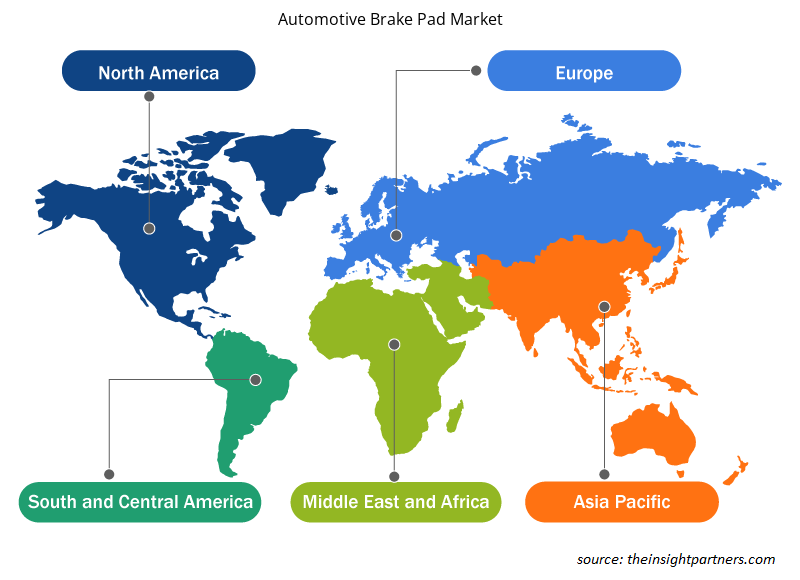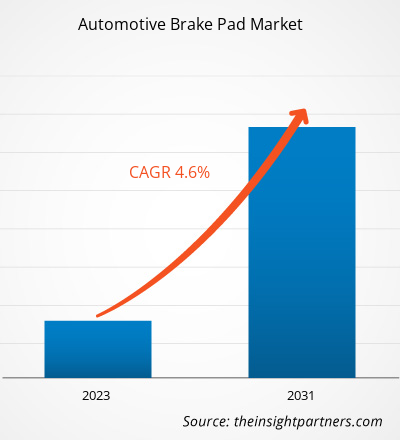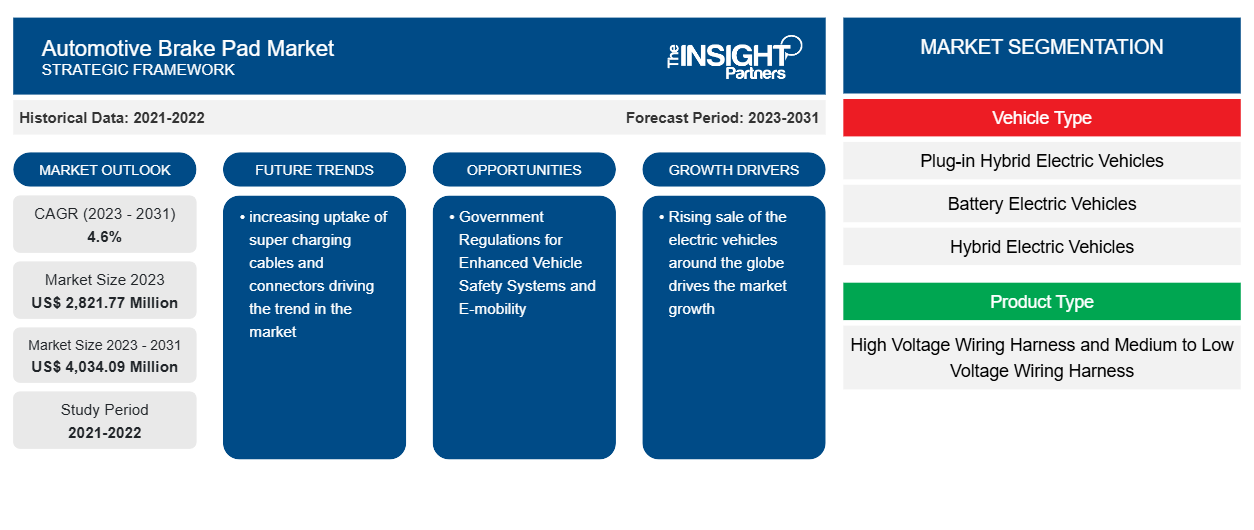Der Markt für Bremsbeläge für Kraftfahrzeuge soll von 2.821,77 Millionen US-Dollar im Jahr 2023 auf 4.034,09 Millionen US-Dollar im Jahr 2031 anwachsen. Der Markt soll zwischen 2023 und 2031 eine durchschnittliche jährliche Wachstumsrate (CAGR) von 4,6 % verzeichnen. Der steigende Verkauf und die Produktion von Nutz- und Personenkraftwagen treiben den Trend auf dem Markt voran.
Analyse des Marktes für Bremsbeläge für Kraftfahrzeuge
Die technologischen Entwicklungen bei Boostern und elektromechanischen Systemen, die zunehmende Nutzung leistungsstärkerer Fahrzeuge und die steigende Nachfrage nach Scheibenbremsen zur Gewährleistung besserer Sicherheit treiben das Marktwachstum des Automobil-Scheibenbremsenmarktes voran. Die hohen Herstellungskosten von Scheibenbremsen können jedoch das Wachstum des Automobil-Scheibenbremsenmarktes bremsen. Darüber hinaus wird erwartet, dass der zunehmende Einsatz von Luftscheibenbremsen in Nutzfahrzeugen und die zunehmende Einführung von Carbon-Keramik-Bremsbelägen im Prognosezeitraum Marktchancen für die Automobil-Scheibenbremse schaffen werden.
Marktübersicht für Kfz-Bremsbeläge
Zu den wichtigsten Akteuren im globalen Ökosystem des Automobil-Scheibenbremsenmarkts gehören Hardware-/Komponentenanbieter, Hersteller von Automobil-Scheibenbremsen, Normungs- und Regulierungsgremien sowie Endverbraucher. Komponenten-/Hardwareanbieter liefern Scheibenbremsenherstellern verschiedene Komponenten/Teile/Rohmaterialien zur Herstellung des Endprodukts. Bremsbeläge, Entlüftungsschraube, Bremssättel, Rotoren und Hardware.
Die Scheibenbremse besteht aus Gusseisen, Aluminium, Edelstahl und vielen weiteren Materialien. Zu den wichtigsten Marktteilnehmern/Herstellern auf dem globalen Markt für Scheibenbremsen für Kraftfahrzeuge zählen unter anderem Thermo Fisher Scientific Inc., Brembo SPA, Continental AG, Knorr-Bremse Group und Robert Bosch GmbH. Bremsbeläge werden hauptsächlich in Personenkraftwagen verwendet, aufgrund ihrer stabilen Leistung bei Bremswiderstand und höheren Geschwindigkeiten finden sie jedoch zunehmend auch im Nutzfahrzeugsegment Verwendung. In Nutzfahrzeugen werden Trommelbremsen durch Scheibenbremsen ersetzt, da sie eine höhere Qualität und längere Lebensdauer bieten. Unternehmen wie Akebono bieten ebenfalls Scheibenbremsen an.
Passen Sie diesen Bericht Ihren Anforderungen an
Sie erhalten kostenlos individuelle Anpassungen an jedem Bericht, einschließlich Teilen dieses Berichts oder einer Analyse auf Länderebene, eines Excel-Datenpakets sowie tolle Angebote und Rabatte für Start-ups und Universitäten.
-
Holen Sie sich die wichtigsten Markttrends aus diesem Bericht.Dieses KOSTENLOSE Beispiel umfasst eine Datenanalyse von Markttrends bis hin zu Schätzungen und Prognosen.
Treiber und Chancen auf dem Kfz-Bremsbelagmarkt
Steigende Zahl von Verkehrsunfällen weltweit mit zunehmenden Verkehrsstaus treibt das Marktwachstum an
Es gibt mehrere andere am Markt beteiligte Randakteure, die eine entscheidende Rolle bei der Ermöglichung des Wachstums und der technologischen Fortschritte im Zusammenhang mit Scheibenbremsen für Kraftfahrzeuge spielen. Die steigende Zahl von Verkehrsunfällen aufgrund von Fahrzeugen erfordert Sicherheitsvorschriften, was wiederum den Bedarf an Bremssystemregeln und Verkehrssicherheit fördert. Laut der Weltgesundheitsorganisation sterben jedes Jahr etwa 1,19 Millionen Menschen. Zu den wichtigsten Endverbrauchern des Marktes für Bremsbeläge für Kraftfahrzeuge zählen Personenkraftwagen und Nutzfahrzeuge. Darüber hinaus treiben zunehmende Verkehrsstauprobleme in städtischen Gebieten auf der ganzen Welt die Nachfrage nach Bremsbelagprodukten für Kraftfahrzeuge im Prognosezeitraum an.
Erhöhter Verkauf von Elektrofahrzeugen schafft reichlich Gelegenheit für Marktwachstum
Elektrofahrzeuge verwenden Bremsbeläge, um die Bremsanforderungen des Fahrzeugs zu erfüllen. Die Bremsbeläge helfen, Unfälle zu vermeiden. Mit dem steigenden Wachstum der Elektrofahrzeugbranche (EVs) steigt die Nutzung von Bremssystemen exponentiell. Mit dem Ziel, die schädlichen Auswirkungen von Emissionen auf die Umwelt zu reduzieren, unternehmen Regierungsstellen weltweit die notwendigen Schritte, um Elektrofahrzeuge zu fördern. Beispielsweise ist die Electric Vehicles Initiative ein politisches Forum mehrerer Regierungen, das die Einführung und Nutzung von Elektrofahrzeugen fördert. Mit der zunehmenden Nutzung von Elektrofahrzeugen wird auch der Umfang der Verwendung fortschrittlicher Bremssysteme zunehmen. Viele Elektroautos verwenden sowohl regenerative als auch mechanische Bremssysteme. In einem Bremssystem für Elektroautos helfen die regenerativen und mechanischen Bremssysteme, Energie zu sparen.
Segmentierungsanalyse des Marktberichts für Kfz-Bremsbeläge
Wichtige Segmente, die zur Ableitung der Marktanalyse für Autobremsbeläge beigetragen haben, sind Materialtyp, Fahrzeugtyp und Geografie.
- Basierend auf dem Materialtyp ist der Markt in metallische Bremsbeläge, halbmetallische Bremsbeläge, Keramikbremsbeläge, Asbestbremsbeläge und asbestfreie organische Bremsbeläge unterteilt. Unter diesen haben metallische Bremsbeläge im Jahr 2023 den größten Anteil, was auf die weltweit gestiegene Nachfrage nach Personenkraftwagen zurückzuführen ist.
- Je nach Fahrzeugtyp wird der Markt in Nutzfahrzeuge und Personenkraftwagen unterteilt. Darunter hat das Segment der Personenkraftwagen im Jahr 2023 einen größeren Anteil, was auf den weltweiten Pkw-Absatz zurückzuführen ist. Laut der Internationalen Organisation der Kraftfahrzeughersteller erreichte der weltweite Pkw-Absatz im Jahr 2023 65,2 Millionen Einheiten, ein Anstieg gegenüber 58,6 Millionen Einheiten weltweit.
Marktanteilsanalyse für Kfz-Bremsbeläge nach geografischer Lage
Der geografische Umfang des Marktberichts für Kfz-Bremsbeläge ist hauptsächlich in fünf Regionen unterteilt: Nordamerika, Asien-Pazifik, Europa, Naher Osten und Afrika sowie Süd- und Mittelamerika.
Die Region Asien-Pazifik gilt als die am schnellsten wachsende Wirtschaftsregion, wobei China und Indien die am schnellsten wachsenden Volkswirtschaften der Welt sind. Japan ist das technologisch fortschrittlichste Land der Region und bietet Möglichkeiten für die Entwicklung des Marktes für Autoreifen. Schwellenländer in Südostasien wie Vietnam, Malaysia und Indonesien verzeichnen ein Wachstum bei ihren Pkw-Verkäufen, sodass mit einer steigenden Nachfrage nach Bremsbelägen für Autos zu rechnen ist.
Nordamerika wächst aufgrund des gestiegenen Autoabsatzes in den USA und Kanada rasant. Das Nordamerikanische Freihandelsabkommen (NAFTA) ist ein zwischen den USA, Kanada und Mexiko unterzeichnetes Abkommen. Dadurch wurden die meisten tarifären und nichttarifären Handelshemmnisse und Investitionshindernisse zwischen den drei Ländern abgebaut. Dies hat weiter dazu beigetragen, das Handels- und Investitionsniveau in den nordamerikanischen Ländern zu erhöhen. Außerdem entwickelt sich Mexiko zu einer Hochburg für die Automobilherstellung im NAFTA-Raum und liefert seit einigen Jahren jeden Monat Teile im Wert von über 4,3 Milliarden US-Dollar und fertige Fahrzeuge im Wert von 2,6 Milliarden US-Dollar in die USA.
Regionale Einblicke in den Kfz-Bremsbelagmarkt
Die regionalen Trends und Faktoren, die den Markt für Autobremsbeläge im Prognosezeitraum beeinflussen, wurden von den Analysten von Insight Partners ausführlich erläutert. In diesem Abschnitt werden auch die Marktsegmente und die Geografie von Autobremsbelägen in Nordamerika, Europa, im asiatisch-pazifischen Raum, im Nahen Osten und Afrika sowie in Süd- und Mittelamerika erörtert.

- Erhalten Sie regionale Daten zum Automobil-Bremsbelagmarkt
Umfang des Marktberichts zu Bremsbelägen für Kraftfahrzeuge
| Berichtsattribut | Details |
|---|---|
| Marktgröße im Jahr 2023 | 2.821,77 Millionen US-Dollar |
| Marktgröße bis 2031 | 4.034,09 Millionen US-Dollar |
| Globale CAGR (2023 - 2031) | 4,6 % |
| Historische Daten | 2021-2022 |
| Prognosezeitraum | 2023–2031 |
| Abgedeckte Segmente |
Nach Fahrzeugtyp
|
| Abgedeckte Regionen und Länder |
Nordamerika
|
| Marktführer und wichtige Unternehmensprofile |
|
Marktteilnehmerdichte: Der Einfluss auf die Geschäftsdynamik
Der Markt für Bremsbeläge für Kraftfahrzeuge wächst rasant. Dies wird durch die steigende Nachfrage der Endverbraucher aufgrund von Faktoren wie sich entwickelnden Verbraucherpräferenzen, technologischen Fortschritten und einem größeren Bewusstsein für die Vorteile des Produkts vorangetrieben. Mit der steigenden Nachfrage erweitern Unternehmen ihr Angebot, entwickeln Innovationen, um die Bedürfnisse der Verbraucher zu erfüllen, und nutzen neue Trends, was das Marktwachstum weiter ankurbelt.
Die Marktteilnehmerdichte bezieht sich auf die Verteilung der Firmen oder Unternehmen, die in einem bestimmten Markt oder einer bestimmten Branche tätig sind. Sie gibt an, wie viele Wettbewerber (Marktteilnehmer) in einem bestimmten Marktraum im Verhältnis zu seiner Größe oder seinem gesamten Marktwert präsent sind.
Die wichtigsten auf dem Markt für Kfz-Bremsbeläge tätigen Unternehmen sind:
- Coroplast Fritz Müller GmbH & Co. KG
- Fujikura Ltd.
- Furukawa Electric Co. Ltd.
- Motherson Sumi Systems Ltd.
- Nexans Autoelectric GmbH
- Sinbon Electronics Co.
Haftungsausschluss : Die oben aufgeführten Unternehmen sind nicht in einer bestimmten Reihenfolge aufgeführt.

- Überblick über die wichtigsten Akteure auf dem Markt für Kfz-Bremsbeläge
Neuigkeiten und aktuelle Entwicklungen zum Kfz-Bremsbelagmarkt
Der Markt für Autobremsbeläge wird durch die Erhebung qualitativer und quantitativer Daten nach Primär- und Sekundärforschung bewertet, die wichtige Unternehmensveröffentlichungen, Verbandsdaten und Datenbanken umfasst. Nachfolgend sind einige der Entwicklungen auf dem Markt für Autobremsbeläge aufgeführt:
- Delphi kündigt die Einführung seiner neuen BEV-Bremsbeläge an, die speziell auf die Anforderungen von BEV-Anwendungen zugeschnitten sind. Basierend auf detaillierten Vergleichen gehört dieses Sortiment heute zu den umfassendsten der Welt und deckt die beliebtesten Modelle im unabhängigen Ersatzteilmarkt ab. Zu den Fahrzeugen gehören der Nissan Leaf und das Tesla Model S/Model 3 sowie die neuesten Modelle wie BMW i4/iX, Mercedes EQC/EQEE/QS und Porsche Taycan/Cross Turismo. Mit der Einführung von 52 Teilenummern, die 2,7 Millionen in Europa in Betrieb befindliche Fahrzeuge abdecken, bietet Delphi Werkstätten eine umfassende Servicemöglichkeit. (Quelle: Unternehmenswebsite, Februar 2024)
- Allied Nippon hat EV+ auf den Markt gebracht, eine brandneue, voll ausgestattete Bremsbelagserie für Elektrofahrzeuge. (Quelle: Pressemitteilung, Juni 2023)
Marktbericht zu Bremsbelägen für Kraftfahrzeuge – Umfang und Ergebnisse
Der Bericht „Marktgröße und Prognose für Bremsbeläge für Kraftfahrzeuge (2021–2031)“ bietet eine detaillierte Analyse des Marktes, die die folgenden Bereiche abdeckt:
- Marktgröße und Prognose für Kfz-Bremsbeläge auf globaler, regionaler und Länderebene für alle wichtigen Marktsegmente, die im Rahmen des Berichts abgedeckt sind
- Markttrends für Bremsbeläge für Kraftfahrzeuge sowie Marktdynamik wie Treiber, Einschränkungen und wichtige Chancen
- Detaillierte PEST- und SWOT-Analyse
- Analyse des Automobilbremsbelagmarktes mit wichtigen Markttrends, globalen und regionalen Rahmenbedingungen, wichtigen Akteuren, Vorschriften und aktuellen Marktentwicklungen
- Branchenlandschaft und Wettbewerbsanalyse, die die Marktkonzentration, Heatmap-Analyse, prominente Akteure und aktuelle Entwicklungen auf dem Markt für Kfz-Bremsbeläge umfasst
- Detaillierte Firmenprofile
- Historische Analyse (2 Jahre), Basisjahr, Prognose (7 Jahre) mit CAGR
- PEST- und SWOT-Analyse
- Marktgröße Wert/Volumen – Global, Regional, Land
- Branchen- und Wettbewerbslandschaft
- Excel-Datensatz
Aktuelle Berichte
Erfahrungsberichte
Grund zum Kauf
- Fundierte Entscheidungsfindung
- Marktdynamik verstehen
- Wettbewerbsanalyse
- Kundeneinblicke
- Marktprognosen
- Risikominimierung
- Strategische Planung
- Investitionsbegründung
- Identifizierung neuer Märkte
- Verbesserung von Marketingstrategien
- Steigerung der Betriebseffizienz
- Anpassung an regulatorische Trends























 Kostenlose Probe anfordern für - Markt für Kfz-Bremsbeläge
Kostenlose Probe anfordern für - Markt für Kfz-Bremsbeläge